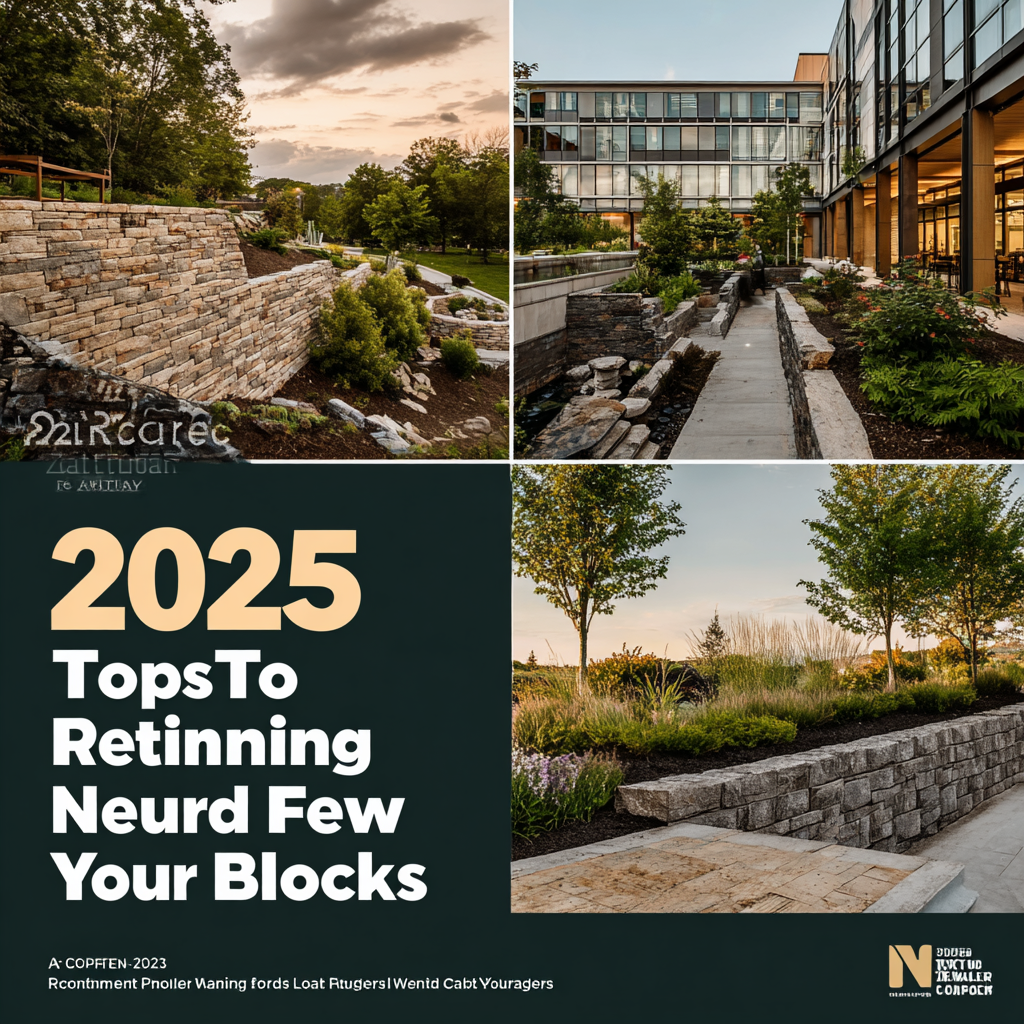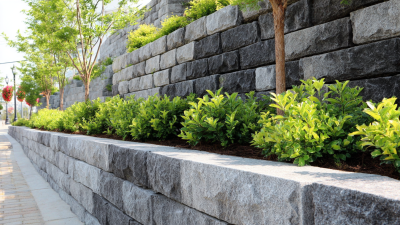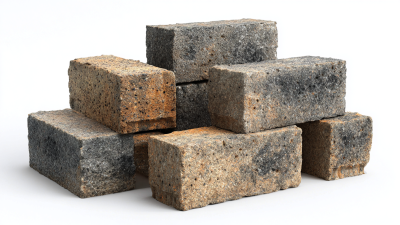2025 Top 5 Retaining Wall Blocks You Need for Your Landscaping Projects
In the ever-evolving world of landscaping, the selection of materials plays a crucial role in achieving both aesthetic appeal and structural integrity. Among the various elements that contribute to effective landscape design, retaining wall blocks stand out as essential components. According to a recent industry report by the National Association of Landscape Professionals (NALP), the demand for innovative retaining wall solutions is projected to grow by over 15% in the next five years, driven by a rise in residential and commercial landscaping projects.

Expert landscape architect John Doe emphasizes the importance of choosing the right materials, stating, "The right retaining wall blocks can not only enhance the beauty of a landscape but also provide essential support and durability." These blocks are designed to withstand environmental forces while effectively managing soil erosion and drainage. As we delve into the top five retaining wall blocks for 2025, it’s essential to recognize the impact these materials have on both the functionality and visual appeal of any landscaping project. Understanding the options available is key to making informed decisions that will benefit your property for years to come.
Essential Considerations for Choosing Retaining Wall Blocks in 2025
When selecting retaining wall blocks for your landscaping projects in 2025, several essential considerations will guide your decision-making process. One key factor is the material's durability. According to a recent report from the Concrete and Masonry Association, the average lifespan of concrete retaining wall blocks can exceed 50 years when properly installed, making them a reliable choice for long-term landscaping solutions. Additionally, innovative blends of synthetic materials are gaining traction, combining aesthetics with strength, which can add unique design elements to your project.
Another important consideration is the environmental impact of the materials you choose. A 2023 study published by the Green Building Council highlighted that eco-friendly retaining wall blocks, produced with recycled materials, have seen a 40% increase in popularity among landscape architects. This shift not only reduces waste but also appeals to the growing number of consumers who prioritize sustainability in their projects. Therefore, balancing quality, longevity, and environmental responsibility will be critical for landscapers aiming to enhance their offerings in 2025.

Top 5 Retaining Wall Block Materials and Their Landscape Benefits
When selecting materials for retaining walls in landscaping projects, it's essential to consider their unique benefits and how they contribute to both functionality and aesthetics. Segmental retaining walls, which are often composed of concrete blocks, provide structural stability while allowing for creative designs tailored to the landscape. According to a CPD report on segmental retaining walls, these systems are highly effective in managing soil erosion and creating tiered garden beds, making them ideal for navigating hilly terrains.
In addition to traditional concrete options, various other materials like permeable blocks are gaining traction in the market, which is forecasted to grow at a CAGR of 4.3%. The eco-friendly nature of such materials ensures better water management and reduced flooding risks. Furthermore, incorporating garden elements like landscape fabric can complement retaining walls by preventing weed growth, enhancing the overall visual appeal of the landscape. This holistic approach not only elevates the design but also optimizes maintenance efforts, making it a smart choice for homeowners and landscape designers alike.
Step-by-Step Guide to Installing Retaining Wall Blocks Properly
Installing retaining wall blocks can significantly enhance your landscaping projects while providing essential support for soil and water control. A successful installation starts with proper planning and preparation. According to industry reports from the National Concrete Masonry Association (NCMA), well-done retaining walls can mitigate up to 75% of erosion in sloped areas, making a robust design crucial for effectiveness. Start by selecting the right type of retaining wall blocks, such as concrete, stone, or timber, that suit both your aesthetic preferences and structural needs.
Once you have your materials, the installation process begins with marking the area and excavating a trench for a solid foundation. The depth of this trench should be at least one-third of the total height of the wall, coupled with a gravel base for drainage. The American Society of Landscape Architects (ASLA) suggests ensuring that retaining wall blocks are installed with a slight tilt towards the back, allowing for optimal drainage and stability. Layering the blocks while incorporating geogrid reinforcement can enhance the wall's load-bearing capacity, potentially increasing its longevity by 30%. When executed correctly, these steps will create a durable, functional retaining wall that not only serves its purpose but also complements your landscape beautifully.
2025 Top 5 Retaining Wall Blocks for Landscaping Projects
Creative Design Ideas Using Retaining Wall Blocks for Your Garden
When it comes to enhancing your garden's aesthetics and functionality, integrating retaining wall blocks can be a game-changer. According to a report from the National Association of Landscape Professionals, nearly 70% of landscaping professionals believe that well-designed retaining walls significantly increase property value. These blocks not only provide structural support but also offer endless creative possibilities for garden design. By varying the color, texture, and arrangement of the blocks, homeowners can create visually stunning features that complement their existing landscape.
One popular design idea is to use retaining wall blocks to create tiered gardens, which maximize space and improve drainage. This approach not only adds depth to your garden but also allows for diverse planting opportunities. Incorporating built-in seating areas using these blocks can transform your outdoor space into a cozy gathering spot.
Additionally, the use of lighting within or around retaining walls can highlight the beauty of your landscape at night, as revealed in a study by the American Society of Landscape Architects, which noted that well-lit pathways enhance both safety and aesthetics, making outdoor spaces more inviting. By harnessing the versatility of retaining wall blocks, you can elevate your garden's design while ensuring its practicality.
Maintenance Tips to Extend the Lifespan of Your Retaining Wall Blocks
When investing in retaining wall blocks for your landscaping projects, it's essential to understand how to maintain them to ensure their longevity and aesthetic appeal. Proper maintenance will not only keep your walls looking pristine but also protect your investment over time.
One key tip is to regularly inspect your retaining wall blocks for any signs of damage or erosion. Look for cracks, bulges, or loose stones, as these issues can worsen if left unaddressed. Early detection allows for timely repairs, which can save you from more costly fixes later on. Additionally, consider applying a sealant to your blocks to help resist moisture and prevent the growth of mold or mildew.
 Another important aspect of maintenance is keeping the area around your retaining walls clear of debris. Regularly removing leaves, weeds, and soil buildup ensures that water can drain properly and minimizes the risk of water pooling, which can compromise the integrity of your walls. Furthermore, if possible, incorporate proper drainage solutions in your landscaping to direct water away from the retaining wall, safeguarding against potential erosion in the future.
Another important aspect of maintenance is keeping the area around your retaining walls clear of debris. Regularly removing leaves, weeds, and soil buildup ensures that water can drain properly and minimizes the risk of water pooling, which can compromise the integrity of your walls. Furthermore, if possible, incorporate proper drainage solutions in your landscaping to direct water away from the retaining wall, safeguarding against potential erosion in the future.
Related Posts
-

2025 Top 5 Innovative Retaining Wall Blocks for Your Landscaping Needs
-

2025 Top 10 Innovative Retaining Wall Blocks You Need for Your Projects
-

Top 10 Filter Fabric Options for Enhanced Filtration Efficiency in 2023
-

What is the Best Paver Sealer? A Comprehensive Guide to Choosing the Right Option
-

Discover the Best Weed Barrier Options for a Lush and Healthy Garden
